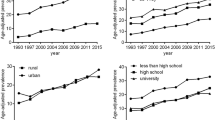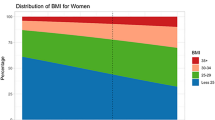Abstract
Background
Most previous studies on trends in the prevalence of obesity or abdominal obesity in Chinese adults were based on regional data and/or short time intervals, and recent trends are not available. We aimed to examine the secular trends in the prevalence of overweight, obesity, and abdominal obesity among Chinese adults at the national level from 1993 to 2015.
Methods
A total of 70,242 Chinese adults aged 18–80 years were from the cross-sectional surveys conducted from 1993 to 2015. According to the World Health Organization criteria, overweight was defined as body mass index (BMI) ≥23.0 kg/m2 and <27.5 kg/m2, and obesity was defined as BMI ≥27.5 kg/m2. According to the International Diabetes Federation criteria, abdominal obesity was defined as waist circumference (WC) ≥90 cm for men and ≥80 cm for women. Mean values and prevalence of adiposity markers were standardized to the age distribution of the China population in 2010.
Results
Between 1993 and 2015, and based on age-standardized values, mean BMI increased from 21.9 kg/m2 in 1993 to 23.9 kg/m2 (+2.0 kg/m2) in 2015 (P for trend < 0.001), and mean WC increased from 76.0 cm to 83.4 cm (+7.4 cm) (P for trend <0.001). From 1993 to 2015, the prevalence increased from 26.6% to 41.3% (+14.7%) for overweight, from 4.2% to 15.7% (+11.5%) for obesity, and from 20.2% to 46.9% (+26.7%) for abdominal obesity (all P for trends < 0.001). In multivariate linear regression analysis, time (calendar years), older age and urban regions were strongly and independently associated with BMI.
Conclusions
The prevalence of overweight, obesity, and abdominal obesity increased markedly among Chinese adults during the past two decades. Weight control programs and public health measures to address the societal causes of obesity should be strengthened.
This is a preview of subscription content, access via your institution
Access options
Subscribe to this journal
Receive 12 print issues and online access
$259.00 per year
only $21.58 per issue
Buy this article
- Purchase on Springer Link
- Instant access to full article PDF
Prices may be subject to local taxes which are calculated during checkout


Similar content being viewed by others
References
GBD 2015 Obesity Collaborators. Health effects of overweight and obesity in 195 countries over 25 years. N Engl J Med. 2017;377:13–27.
Bays HE, Toth PP, Kris-Etherton PM, Abate N, Aronne LJ, Brown WV, et al. Obesity, adiposity, and dyslipidemia: a consensus statement from the National Lipid Association. J Clin Lipidol. 2013;7:304–83.
Piche ME, Poirier P, Lemieux I, Despres JP. Overview of epidemiology and contribution of obesity and body fat distribution to cardiovascular disease: an update. Prog Cardiovasc Dis. 2018;61:103–13.
De Pergola G, Silvestris F. Obesity as a major risk factor for cancer. J Obes. 2013;2013:291546.
Bhaskaran K, dos-Santos-Silva I, Leon DA, Douglas IJ, Smeeth L. Association of BMI with overall and cause-specific mortality: a population-based cohort study of 3·6 million adults in the UK. The Lancet Diabetes Endocrinol. 2018;6:944–53.
Apovian CM. Obesity: definition, comorbidities, causes, and burden. Am J Manag Care. 2016;22:s176–85.
Foucan L, Hanley J, Deloumeaux J, Suissa S. Body mass index (BMI) and waist circumference (WC) as screening tools for cardiovascular risk factors in Guadeloupean women. J Clin Epidemiol. 2002;55:990–6.
Janssen I, Katzmarzyk PT, Ross R. Waist circumference and not body mass index explains obesity-related health risk. Am J Clin Nutr. 2004;79:379–84.
Hu J, Yang S, Zhang A, Yang P, Cao X, Li X, et al. Abdominal obesity is more closely associated with diabetic kidney disease than general obesity. Diabetes Care. 2016;39:e179–80.
Goryakin Y, Lobstein T, James WPT, Suhrcke M. The impact of economic, political and social globalization on overweight and obesity in the 56 low and middle income countries. Soc Sci Med. 2015;133:67–76.
Hou XH, Liu Y, Lu HJ, Ma XJ, Hu C, Bao YQ, et al. Ten-year changes in the prevalence of overweight, obesity and central obesity among the Chinese adults in urban Shanghai, 1998–2007—comparison of two cross-sectional surveys. BMC Public Health. 2013;13:1064
Xi B, Liang Y, He T, Reilly KH, Hu Y, Wang Q, et al. Secular trends in the prevalence of general and abdominal obesity among Chinese adults, 1993–2009. Obes Rev. 2012;13:287–96.
Zhai Y, Fang HY, Yu WT, Yu DM, Zhao LY, Liang XF, et al. Changes in waist circumference and abdominal obesity among Chinese adults over a ten-year period. Biomed Environ Sci. 2017;30:315–22.
Zhang B, Zhai FY, Du SF, Popkin BM. The China health and nutrition survey 1989-2011. Obes Rev. 2014;15:2–7.
World Health Organization. Physical status: the use and interpretation of anthropometry. Report of a WHO Expert Committee. WHO Technical Report Series. 1995;854:1–452.
World Health Organization. Expert consultation. Appropriate body-mass index for Asian populations and its implications for policy and intervention strategies. Lancet. 2004;363:157–63.
KGMM Alberti, Zimmet P, Shaw J. The metabolic syndrome—a new worldwide definition. The Lancet. 2005;366:1059–62.
National Health and Family Planning Commission of the People’s Republic of China. WST 428-2013 Criteria of weight for adults. Standards Press of China: Beijing.
Mi YJ, Zhang B, Wang HJ, Yan J, Han W, Zhao J, et al. Prevalence and secular trends in obesity among Chinese adults, 1991–2011. Am J Prev Med. 2015;49:661–9.
He Y, Pan A, Yang Y, Wang Y, Xu J, Zhang Y, et al. prevalence of underweight, overweight, and obesity among reproductive-age women and adolescent girls in rural China. Am J Public Health. 2016;106:2103–10.
Wan Y, Jiang X, He Y, Zhang Y, Liang Y, Pan F, et al. Body mass index of young men in china: results from four national surveys conducted between 1955 and 2012. Medicine (Baltim). 2016;95:e2829.
Wu J, Xu H, He X, Yuan Y, Wang C, Sun J, et al. Six-year changes in the prevalence of obesity and obesity-related diseases in Northeastern China from 2007 to 2013. Sci Rep. 2017;7:41518.
Wang Y, Pan L, Wan S, Yi H, Yang F, He H, et al. Increasing prevalence of overweight and obesity in Yi farmers and migrants from 2007 to 2015 in China: the Yi migrant study. BMC Public Health. 2018;18:659.
Sun J, Zhou W, Gu T, Zhu D, Bi Y. A retrospective study on association between obesity and cardiovascular risk diseases with aging in Chinese adults. Sci Rep. 2018;8:5806.
Zhang J, Wan S, Zhang B, Dong F, Pan L, Yihuo W, et al. Twenty-year time trends in hypertension prevalence in Yi people of China: three successive cross-sectional studies, 1996–2015. BMJ Open. 2018;8:e022714.
Shen C, Zhou Z, Lai S, Tao X, Zhao D, Dong W, et al. Urban-rural-specific trend in prevalence of general and central obesity, and association with hypertension in Chinese adults, aged 18-65 years. BMC Public Health. 2019;19:661.
Nie P, Ding L, Sousa-Poza A. Decomposing adult obesity trends in China (1991–2011). Econ Hum Biol. 2019;34:5–15.
Chen YJ, Peng Q, Yang Y, Zheng S, Wang Y, Lu W. The prevalence and increasing trends of overweight, general obesity, and abdominal obesity among Chinese adults: a repeated cross-sectional study. BMC Public Health. 2019;19:1293.
Du P, Zhang B, Wang HJ, Qi SF, Mi YJ, Yao JC, et al. The prevalence and secular trends of abdominal obesity among Chinese adults, 1993–2011. Ann Epidemiol. 2015;25:797–9.
Keating C, Backholer K, Gearon E, Stevenson C, Swinburn B, Moodie M, et al. Prevalence of class-I, class-II and class-III obesity in Australian adults between 1995 and 2011–12. Obes Res Clin Pract. 2015;9:553–62.
Flegal KM, Kruszon-Moran D, Carroll MD, Fryar CD, Ogden CL. Trends in obesity among adults in the United States, 2005 to 2014. JAMA. 2016;315:2284–91.
Heiniger S, Viswanathan B, Gedeon J, Paccaud F, Bovet P. Trends in prevalence, awareness, treatment and control of high blood pressure in the Seychelles between 1989 and 2013. J Hypertens. 2017;35:1465–73.
Shin HY, Kang HT. Recent trends in the prevalence of underweight, overweight, and obesity in Korean adults: the Korean National Health and Nutrition Examination Survey from 1998 to 2014. J Epidemiol. 2017;27:413–9.
NCD Risk Factor Collaboration. Trends in adult body-mass index in 200 countries from 1975 to 2014: a pooled analysis of 1698 population-based measurement studies with 19·2 million participants. Lancet. 2016;387:1377–96.
Caspard H, Jabbour S, Hammar N, Fenici P, Sheehan JJ, Kosiborod M. Recent trends in the prevalence of type 2 diabetes and the association with abdominal obesity lead to growing health disparities in the USA: An analysis of the NHANES surveys from 1999 to 2014. Diabetes Obes Metab. 2018;20:667–71.
Popkin BM. Synthesis and implications: China’s nutrition transition in the context of changes across other low- and middle-income countries. Obes Rev. 2014;15:60–7.
Li Y, Wang DD, Ley SH, Howard AG, He Y, Lu Y, et al. Potential impact of time trend of life-style factors on cardiovascular disease burden in China. J Am Coll Cardiol. 2016;68:818–33.
Qin L, Stolk RP, Corpeleijn E. Motorized transportation, social status, and adiposity: the China Health and Nutrition Survey. Am J Prev Med. 2012;43:1–10.
Monteiro CA, Moubarac JC, Cannon G, Ng SW, Popkin B. Ultra-processed products are becoming dominant in the global food system. Obes Rev. 2013;14:21–8.
Wang K, Liang R, Ma ZL, Chen J, Cheung EFC, Roalf DR, et al. Body image attitude among Chinese college students. Psych J. 2018;7:31–40.
NCD Risk Factor Collaboration. Rising rural body-mass index is the main driver of the global obesity epidemic in adults. Nature. 2019;569:260–4.
Pickett W, King N, Lawson J, Dosman JA, Trask C, Brison RJ, et al. Farmers, mechanized work, and links to obesity. Prev Med. 2015;70:59–63.
Ashwell M, Gunn P, Gibson S. Waist-to-height ratio is a better screening tool than waist circumference and BMI for adult cardiometabolic risk factors: systematic review and meta-analysis. Obes Rev. 2012;13:275–86.
Swinburn BA, Kraak VI, Allender S, Atkins VJ, Baker PI, Bogard JR, et al. The global syndemic of obesity, undernutrition, and climate change: the lancet commission report. Lancet. 2019;393:791–846.
Erion KA, Corkey BE. Hyperinsulinemia: a cause of obesity? Curr Obes Rep. 2017;6:178–86.
Page MM, Johnson JD. Mild suppression of hyperinsulinemia to treat obesity and insulin resistance. Trends Endocrinol Metab. 2018;29:389–99.
Templeman NM, Skovsø S, Page MM, Lim GE, Johnson JD. A causal role for hyperinsulinemia in obesity. J Endocrinol. 2017;232:R173–83.
Nugent R, Fottrell E. Non-communicable diseases and climate change: linked global emergencies. Lancet. 2019;394:622–3.
Acknowledgements
This study was supported by National Institutes of Health (NIH) (P01-HD28076, HD30880, and HD39183).The authors thank the Chinese Centers for Disease Control and Prevention and the University of North Carolina for sharing their data.
Author information
Authors and Affiliations
Contributions
BX and PB conceptualised and designed the study, supervised the data collation, statistical analyses, and reviewed and revised the manuscript. SM did the statistical analyses, drafted the initial manuscript, and reviewed and revised the manuscript. LY, JS, and MZ reviewed and revised the manuscript. We approved the final manuscript as submitted and agree to be accountable for all aspects of the work.
Corresponding author
Ethics declarations
Conflict of interest
The authors declare that they have no conflict of interest.
Additional information
Publisher’s note Springer Nature remains neutral with regard to jurisdictional claims in published maps and institutional affiliations.
Supplementary information
Rights and permissions
About this article
Cite this article
Ma, S., Xi, B., Yang, L. et al. Trends in the prevalence of overweight, obesity, and abdominal obesity among Chinese adults between 1993 and 2015. Int J Obes 45, 427–437 (2021). https://doi.org/10.1038/s41366-020-00698-x
Received:
Accepted:
Published:
Issue Date:
DOI: https://doi.org/10.1038/s41366-020-00698-x
This article is cited by
-
Long-term trends in Alzheimer’s disease and other dementias deaths with high body mass index in China from 1990 to 2019, and projections up to 2042
Archives of Public Health (2024)
-
Sex-related differences in the hypertriglyceridemic-waist phenotype in association with hyperuricemia: a longitudinal cohort study
Lipids in Health and Disease (2023)
-
Growing old in China in socioeconomic and epidemiological context: systematic review of social care policy for older people
BMC Public Health (2023)
-
Mortality and years of life lost due to pancreatic cancer in China, its provinces, urban and rural areas from 2005 to 2020: results from the national mortality surveillance system
BMC Cancer (2023)
-
Mediation effect of JAK2 methylation on the association between sitting time and abdominal obesity in rural adults
European Journal of Clinical Nutrition (2023)



